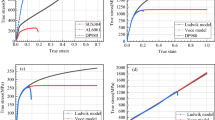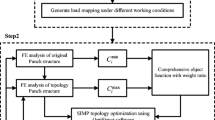Abstract
Sheet metal L-bending processes are widely used for mass production. The design of L-bending processes is connected with time-consuming and costly experiments. Therefore, the finite element simulation of the process could be a helpful tool for the designer and quality assurance of the products. In L-bending process, springback is an important phenomenon, and its accurate prediction is important to control the final shape of the workpiece when the punch is removed. In this study, an optimization algorithm using Gauss–Newton method was developed by coupling the Abaqus/standard code and Python script which is an object-oriented language. For a given bending process problem, the proposed algorithm allows for the optimization of a set of material and/or process factors in order to minimize the workpiece springback. Python scripts allow the direct parameterization of the design variables to be optimized in the finite element input file, and hence an easy use of the procedure within the framework of industrial application. An example is presented in order to optimize three process parameters, namely, die corner radius, punch–die clearance, and the blank holder force. The results demonstrate the reliability of the proposed approach and the fast convergence of the algorithm.
Similar content being viewed by others
References
Zhang ZT, Lee D (1995) Development of a new model for plane strain bending and springback analysis. J Mater Eng Perform 3:291–300. doi:10.1007/BF02649066
Makinouchi A, Nakamichi E, Onate E, Wagoner RH (1995) Prediction of spring-back and side-wall curl in 2-D draw bending. J Mater Process Technol 20:361–374
Date PP, Narashima K, Maiti SK, Singh UP (1999) On the prediction of spring back in vee bending of metallic sheets under plane strain condition. International Conference on Sheet Metal, Earlangen, Germany, pp 447–456
Frank R, Kees D (1994) The influence of the clearance on the springback with bending, International Conference on Sheet Metal. University of Ulster, North Ireland, pp 335–342
Wenner ML (1983) On the work hardening and springback in plane strain draw forming. J Appl Metalwork Vol. 2:277–287. doi:10.1007/BF02833912
Tekiner Z (2004) An experimental study on the examination of springback of sheet metals with several thicknesses and properties in bending dies. J Mater Process Technol 145:109–117. doi:10.1016/j.jmatprotec.2003.07.005
Hill R (1990) Constitutive modeling of orthotropic plasticity in sheet metals. J Mech Phys Solids 38:405–417. doi:10.1016/0022-5096(90)90006-P
Kalpakjian S (1991) Manufacturing process for engineering materials, 2nd edn. Addision-Wesley, USA
Marron G, Bouchêlier C (1995) Le pliage des aciers HLE prévision et maîtrise du retour élastique. Revue de la métallurgie, pp 121–130
Mkaddem A, Saidane D, Onate E, Wagoner RH (2007) Experimental approach and RSM procedure on the examination springback in wiping-die bending process. J Mater Process Technol 189:325–333. doi:10.1016/j.jmatprotec.2007.02.004
Ogawa H (2001) A study of bottoming bend and coining bend of sheet metal. Proceedings of the 9th International Conference on Sheet Metal, pp 247–254
Serruys W (2001) Adaptative bending. Proceedings of the 9th International Conference on Sheet Metal, pp 503–512
Anokye-Siribor K, Singh UP, Agahi P (2000) Determination of spring back in air bending using parabolic model. Proceedings of the 8th International Conference on Sheet Metal, pp 529–540
Livatyali H, Altan T (2001) Prediction and elimination of springback in straight flanging using computer aided design methods. J Mater Process Technol 123:348–354
Han SS, Park KC (1999) An investigation of the factors influencing springback by empirical and simulative techniques. International Conference of Numisheet, Besancon, France, pp 53–57
Panthi SK, Ramakrishnan N, Pathak KK, Chouhan JS (2007) An analysis of springback in sheet metal bending using finite element method (FEM). J Mater Process Technol 186:120–124. doi:10.1016/j.jmatprotec.2006.12.026
Cho JR, Moon SJ, Moon YH, Kang SS (2003) Finite element investigation on springback characteristics in sheet metal U-bending process. J Mater Process Technol 141:109–116. doi:10.1016/S0924-0136(03)00163-8
Li X, Yang Y, Wang Y, Bao J, Li S (2002) Effect of the material-hardening mode on the springback simulation accuracy of V-free bending. J Mater Process Technol 123:209–211
Math M, Grizelj B (2001) Finite element approach in the plate bending process. J Mater Process Technol 125–126:778–784. doi:10.1016/S0924-0136(02)00391-6
Choudhry S, Lee JK (1994) Dynamic plane-strain finite element simulation of industrial sheet-metal forming processes. Int J Mech Sci 36:189–207. doi:10.1016/0020-7403(94)90069-8
Papeleux L, Ponthot JP (2002) Finite element simulation of springback in sheet metal forming. J Mater Process Technol 125–126:785–791. doi:10.1016/S0924-0136(02)00393-X
Chou IN, Hung C (1999) Finite element analysis and optimization on springback reduction. Int J Mach Tools Manuf 39:517–536. doi:10.1016/S0890-6955(98)00031-5
Nocedal J, Wright SJ (1999) Numerical optimization. Springer, New York
Fletcher R (2000) Practical methods of optimization. Wiley, New York
Renner G, Ekárt A (2003) Genetic algorithms in computer aided design. Computer-Aided Des 35:709–726. doi:10.1016/S0010-4485(03)00003-4
Inamdar MV, Date PP, Desai UB (2000) Studies on the prediction of springback in air vee bending of metallic sheets using an artificial neural network. J Mater Process Technol 108:45–54. doi:10.1016/S0924-0136(00)00588-4
Lepadatu D, Hambli H, Kobi A, Barreau A (2005) Optimisation of springback in bending processes using FEM simulation and response surface method. Int J Adv Manuf Technol 27:40–47. doi:10.1007/s00170-004-2146-z
Hibbitt, Krlsson and Sorensen, Inc. (2006) ABAQUS manual
Samuel M (2000) Experimental and numerical prediction of springback and side wall curl in U-bendings of anisotropic sheet metals. J Mater Process Technol 105:382–393. doi:10.1016/S0924-0136(00)00587-2
Kleinermann JP, Ponthot JP (2000) Parameter identification using inverse problems methodology in metal forming simulation. In: Topping BHV (ed) Finite element techniques and development. Proceedings of the Second International Conference on Engineering Computational Technology. Leuven, Belgium, 6–8 Sept, pp 279–284
Author information
Authors and Affiliations
Corresponding author
Rights and permissions
About this article
Cite this article
Gassara, F., Hambli, R., Bouraoui, T. et al. Optimization of springback in L-bending process using a coupled Abaqus/Python algorithm. Int J Adv Manuf Technol 44, 61–67 (2009). https://doi.org/10.1007/s00170-008-1819-4
Received:
Accepted:
Published:
Issue Date:
DOI: https://doi.org/10.1007/s00170-008-1819-4




